Probably one of the most talked about machine learning models, neural networks are computational networks built to model animals' nervous systems. Before getting too deep into the structure, let's take a look at the big advantages of neural networks.
The key component of a neural network is that it is not only a complex structure, but it is also a complex and flexible structure. This means the following two things:
- Neural networks are able to estimate any function shape (this is called being non-parametric)
- Neural networks can adapt and literally change their own internal structure based on their environment
Neural networks are made up of interconnected nodes (perceptrons) that each take in input (quantitative value), and output other quantitative values. Signals travel through the network and eventually end up at a prediction node:
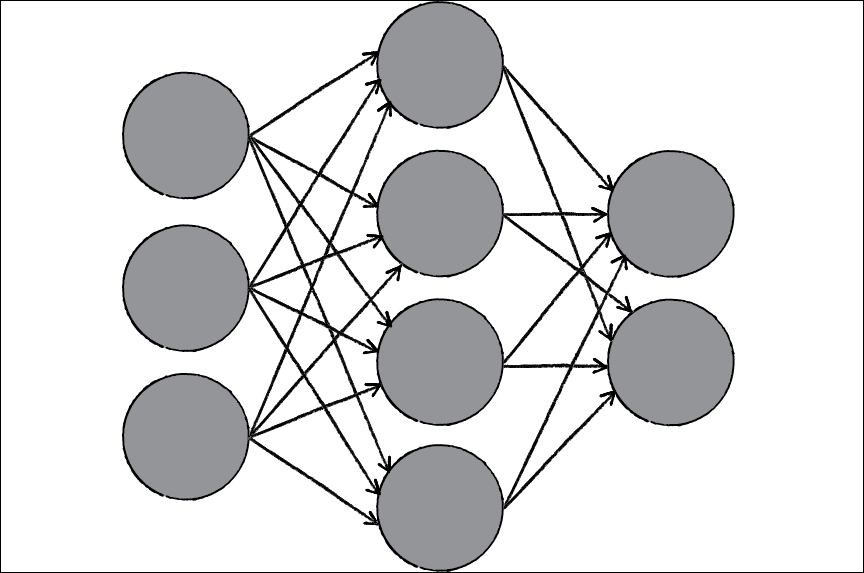
Visualization of neural network interconnected nodes
Another huge advantage of neural networks is that they can be used for supervised learning, unsupervised learning, and reinforcement learning problems. The ability to be so flexible, predict many functional shapes, and adapt to their surroundings make neural networks highly preferable in select fields, as follows:
- Pattern recognition: This is probably the most common application of neural networks. Some examples are handwriting recognition and image processing (facial recognition).
- Entity movement: Examples for this include self-driving cars, robotic animals, and drone movement.
- Anomaly detection: As neural networks are good at recognizing patterns, they can also be used to recognize when a data point does not fit a pattern. Think of a neural network monitoring a stock price movement; after a while of learning the general pattern of a stock price, the network can alert you when something is unusual in the movement.
The simplest form of a neural network is a single perceptron. A perceptron, visualized as follows, takes in some input and outputs a signal:
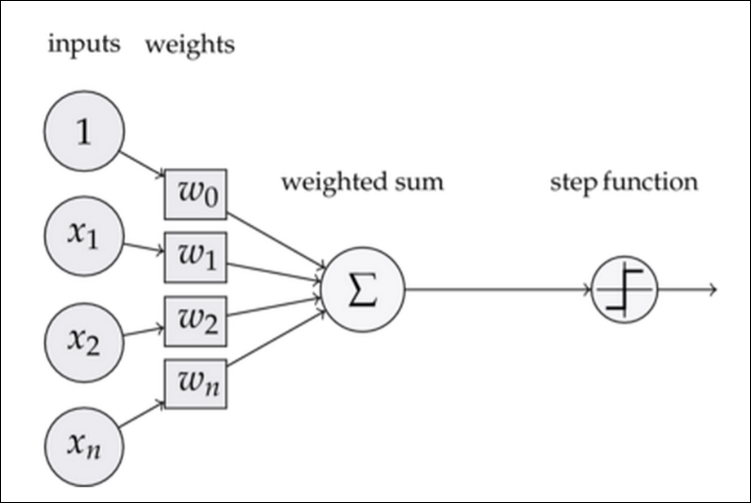
This signal is obtained by combining the input with several weights and then is put through some activation function. In cases of simple binary outputs, we generally use the logistic function, as shown:
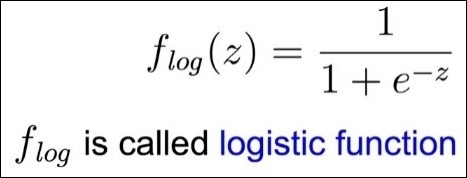
To create a neural network, we need to connect multiple perceptrons to each other in a network fashion, as illustrated in the following graph.
A multilayer perceptron (MLP) is a finite acyclic graph. The nodes are neurons with logistic activation:
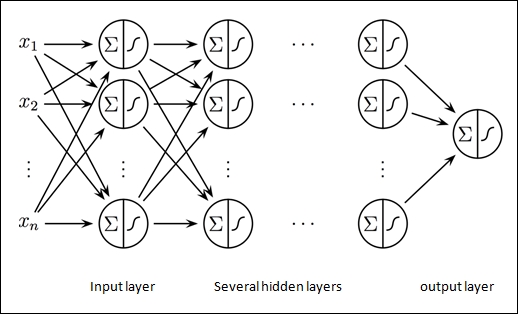
As we train the model, we update the weights (which are random at first) of the model in order to get the best predictions possible. If an observation goes through the model and is outputted as false when it should have been true, the logistic functions in the single perceptrons are changed slightly. This is called back-propagation. Neural networks are usually trained in batches, which means that the network is given several training data points at once several times, and each time, the back-propagation algorithm will trigger an internal weight change in the network.
It isn't hard to see that we can grow the network very deep and have many hidden layers, which are associated with the complexity of the neural network. When we grow our neural networks very deep, we are dipping our toes into the idea of deep learning. The main advantage of deep neural networks (networks with many layers) is that they can approximate almost any shape function and they can (theoretically) learn optimal combinations of features for us and use these combinations to obtain the best predictive power.
Let's see this in action. I will be using a module called PyBrain to make my neural networks. However, first let's take a look at a new dataset, which is a dataset of handwritten digits. We will first try to recognize digits using a random forest, as shown:
from sklearn.cross_validation import cross_val_score from sklearn import datasets import matplotlib.pyplot as plt from sklearn.ensemble import RandomForestClassifier %matplotlib inline digits = datasets.load_digits() plt.imshow(digits.images[100], cmap=plt.cm.gray_r, interpolation='nearest') # a 4 digit
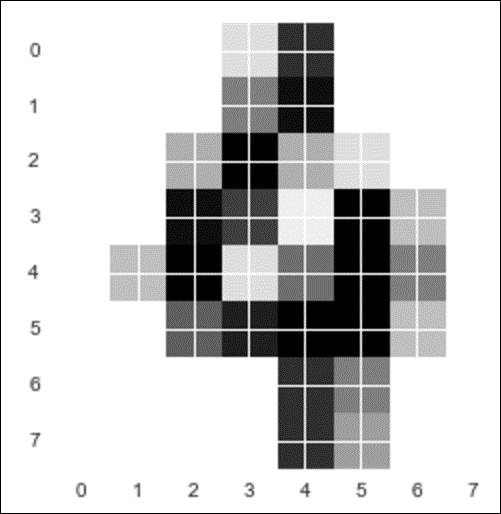
X, y = digits.data, digits.target # 64 pixels per image X[0].shape # Try Random Forest rfclf = RandomForestClassifier(n_estimators=100, random_state=1) cross_val_score(rfclf, X, y, cv=5, scoring='accuracy').mean() 0.9382782
Pretty good! An accuracy of 94% is nothing to laugh at, but can we do even better?
from pybrain.datasets import ClassificationDataSet
from pybrain.utilities import percentError
from pybrain.tools.shortcuts import buildNetwork
from pybrain.supervised.trainers import BackpropTrainer
from pybrain.structure.modules import SoftmaxLayer
from numpy import ravel
# pybrain has its own data sample class that we must add
# our training and test set to
ds = ClassificationDataSet(64, 1 , nb_classes=10)
for k in xrange(len(X)):
ds.addSample(ravel(X[k]),y[k])
# their equivalent of train test split
test_data, training_data = ds.splitWithProportion( 0.25 )
# pybrain's version of dummy variables
test_data._convertToOneOfMany( )
training_data._convertToOneOfMany( )
print test_data.indim # number of pixels going in
# 64
print test_data.outdim # number of possible options (10 digits)
# 10
# instantiate the model with 64 hidden layers (standard params)
fnn = buildNetwork( training_data.indim, 64, training_data.outdim, outclass=SoftmaxLayer )
trainer = BackpropTrainer( fnn, dataset=training_data, momentum=0.1, learningrate=0.01 , verbose=True, weightdecay=0.01)
# change the number of epochs to try to get better results!
trainer.trainEpochs (10) # 10 batches
print 'Percent Error on Test dataset: ' ,
percentError( trainer.testOnClassData (
dataset=test_data )
, test_data['class'] ) The model will output a final error on a test set:
Percent Error on Test dataset: 4.67706013363 accuracy = 1 - .0467706013363 accuracy 0.95322
Already better! Both the random forests and neural networks do very well with this problem because both of them are non-parametric, which means that they do not rely on the underlying shape of the data to make predictions. They are able to estimate any shape of function.
To predict the shape, we can use the following code:
plt.imshow(digits.images[0], cmap=plt.cm.gray_r, interpolation='nearest') fnn.activate(X[0]) array([ 0.92183643, 0.00126609, 0.00303146, 0.00387049, 0.01067609, 0.00718017, 0.00825521, 0.00917995, 0.00696929, 0.02773482])
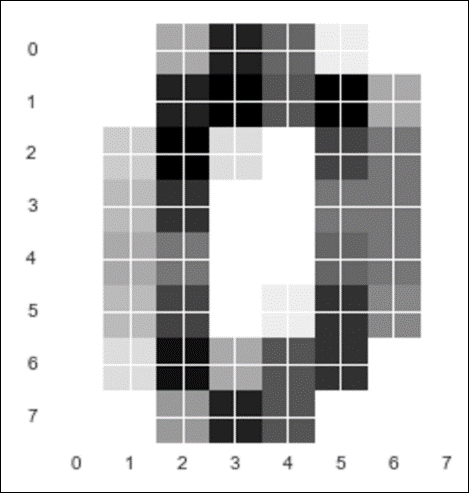
The array represents a probability for every single digit, which means that there is a 92% chance that the digit in the preceding screenshot is a 0 (which it is). Note how the next highest probability is for a 9, which makes sense because 9 and 0 have similar shapes (ovular).
Neural networks do have a major flaw. If left alone, they have a very high variance. To see this, let's run the exact same code as the preceding one and train the exact same type of neural network on the exact same data, as illustrated:
# Do it again and see the difference in error
fnn = buildNetwork( training_data.indim, 64, training_data.outdim, outclass=SoftmaxLayer )
trainer = BackpropTrainer( fnn, dataset=training_data, momentum=0.1, learningrate=0.01 , verbose=True, weightdecay=0.01)
# change the number of eopchs to try to get better results!
trainer.trainEpochs (10)
print ('Percent Error on Test dataset: ' ,
percentError( trainer.testOnClassData (
dataset=test_data )
, test_data['class'] ) )
accuracy = 1 - .0645879732739
accuracy
0.93541 See how just rerunning the model and instantiating different weights made the network turn out to be different than before? This is a symptom of being a high variance model. In addition, neural networks generally require many training samples in order to combat the high variances of the model and also require a large amount of computation power to work well in production environments.
